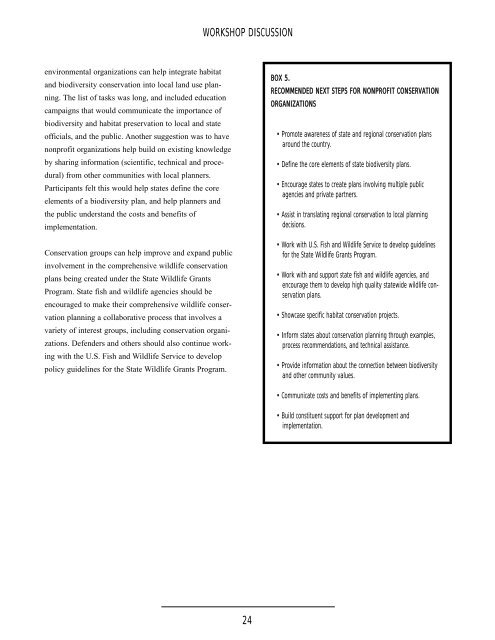Integrating Land Use Planning and Biodiversity - Defenders of Wildlife
Integrating Land Use Planning and Biodiversity - Defenders of Wildlife
Integrating Land Use Planning and Biodiversity - Defenders of Wildlife
You also want an ePaper? Increase the reach of your titles
YUMPU automatically turns print PDFs into web optimized ePapers that Google loves.
WORKSHOP DISCUSSION<br />
environmental organizations can help integrate habitat<br />
<strong>and</strong> biodiversity conservation into local l<strong>and</strong> use planning.<br />
The list <strong>of</strong> tasks was long, <strong>and</strong> included education<br />
campaigns that would communicate the importance <strong>of</strong><br />
biodiversity <strong>and</strong> habitat preservation to local <strong>and</strong> state<br />
<strong>of</strong>ficials, <strong>and</strong> the public. Another suggestion was to have<br />
nonpr<strong>of</strong>it organizations help build on existing knowledge<br />
by sharing information (scientific, technical <strong>and</strong> procedural)<br />
from other communities with local planners.<br />
Participants felt this would help states define the core<br />
elements <strong>of</strong> a biodiversity plan, <strong>and</strong> help planners <strong>and</strong><br />
the public underst<strong>and</strong> the costs <strong>and</strong> benefits <strong>of</strong><br />
implementation.<br />
Conservation groups can help improve <strong>and</strong> exp<strong>and</strong> public<br />
involvement in the comprehensive wildlife conservation<br />
plans being created under the State <strong>Wildlife</strong> Grants<br />
Program. State fish <strong>and</strong> wildlife agencies should be<br />
encouraged to make their comprehensive wildlife conservation<br />
planning a collaborative process that involves a<br />
variety <strong>of</strong> interest groups, including conservation organizations.<br />
<strong>Defenders</strong> <strong>and</strong> others should also continue working<br />
with the U.S. Fish <strong>and</strong> <strong>Wildlife</strong> Service to develop<br />
policy guidelines for the State <strong>Wildlife</strong> Grants Program.<br />
BOX 5.<br />
RECOMMENDED NEXT STEPS FOR NONPROFIT CONSERVATION<br />
ORGANIZATIONS<br />
• Promote awareness <strong>of</strong> state <strong>and</strong> regional conservation plans<br />
around the country.<br />
• Define the core elements <strong>of</strong> state biodiversity plans.<br />
• Encourage states to create plans involving multiple public<br />
agencies <strong>and</strong> private partners.<br />
• Assist in translating regional conservation to local planning<br />
decisions.<br />
• Work with U.S. Fish <strong>and</strong> <strong>Wildlife</strong> Service to develop guidelines<br />
for the State <strong>Wildlife</strong> Grants Program.<br />
• Work with <strong>and</strong> support state fish <strong>and</strong> wildlife agencies, <strong>and</strong><br />
encourage them to develop high quality statewide wildlife conservation<br />
plans.<br />
• Showcase specific habitat conservation projects.<br />
• Inform states about conservation planning through examples,<br />
process recommendations, <strong>and</strong> technical assistance.<br />
• Provide information about the connection between biodiversity<br />
<strong>and</strong> other community values.<br />
• Communicate costs <strong>and</strong> benefits <strong>of</strong> implementing plans.<br />
• Build constituent support for plan development <strong>and</strong><br />
implementation.<br />
24
















![[PDF] Community Development Toolkit - CommDev](https://img.yumpu.com/48616495/1/184x260/pdf-community-development-toolkit-commdev.jpg?quality=85)
